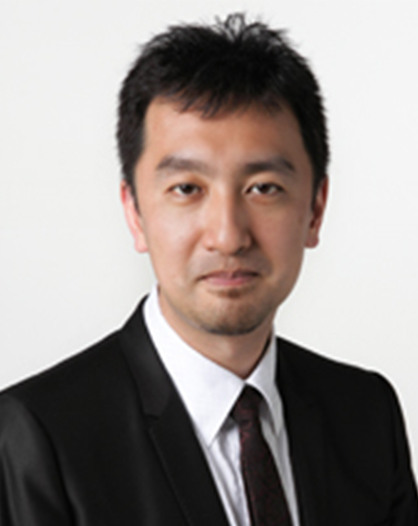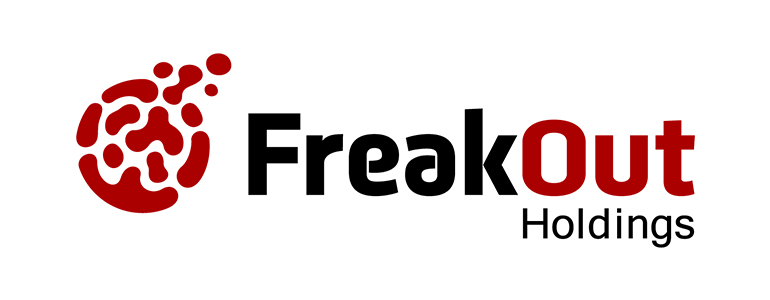| FreakOut Holdings, inc. (6094) |
|
||||||||
Company |
FreakOut Holdings, inc. |
||
Code No. |
6094 |
||
Exchange |
TSE Mothers |
||
Industry |
Service |
||
President |
Yuzuru Honda |
||
Address |
Roppongi Hills Cross Point, 6-3-1 Roppongi, Minato-ku, Tokyo |
||
Year-end |
End of September |
||
URL |
|||
* The share price is the closing price on June 1.
The number of shares issued is from the brief financial report for the latest period. ROE and BPS are the values from the previous term. |
||||||||||||||||||||||||
|
|
* The forecasted values were provided by the company. On Sep. 1, 2016, the company conducted a 2-for-1 stock split.
EPS was adjusted retroactively.
Net income is profit attributable to owners of the parent company. Hereinafter the same shall apply. This Bridge Report presents an overview of FreakOut Holdings, inc.'s earnings results for the first half of fiscal year ending September 2018, and more. |
| Key Points |
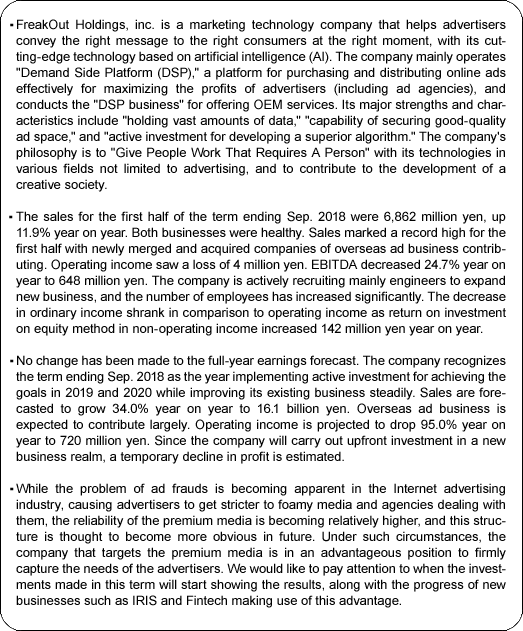 |
| Company Overview |
|
FreakOut Holdings, inc. is a marketing technology company that solves advertisers' challenges of conveying the right message to the right consumers at the right moment with its cutting-edge technology using AI (artificial intelligence). Its chief business is the "DSP business," including the operation of "DSP (demand-side platform)"- a platform that enables advertisers and advertising agencies to buy Internet advertisements efficiently and distribute them to maximize profit - and OEM.
Its major strengths and characteristics include "holding vast amounts of data," "capability of securing good-quality ad space," and "active investment for developing a superior algorithm."
The company's philosophy is to "Give People Work That Requires A Person" with its technologies in various fields not limited to advertisement, and to contribute to the development of a creative society.
 1-1 Corporate History 1-1 Corporate History FreakOut was founded in October 2010 by its Founder & Global CEO Yuzuru Honda, an engineer with the previous experience of engaging in advertising businesses at Yahoo! Japan Corporation, who wanted to bring about a game change in advertising in Japan by introducing RTB(Real-Time Bidding) - a distribution method that automatically trades advertisement spaces in the form of bidding according to the number of times an Internet advertisement is displayed -, which already became a norm in the USA about a year earlier than in Japan. Joined the start-up by the Representative Director, Yusuke Sato, also an engineer who worked on advertisement products at Google Japan, the company was the first in Japan to commercialize the RTB technologies in January 2011.
Helped by the feature of high sensitivity to new products of the advertising industry, the company gained numerous corporate clients soon after its launch while its customer satisfaction level has remained high, pushing both its sales and profits constantly upward. In June 2014, the company was listed on TSE Mothers in less than four years after its founding.
In January 2017, the company changed its structure to a holding company to actualize faster decision-making and more dynamic business development.
FreakOut was founded in October 2010 by its Founder & Global CEO Yuzuru Honda, an engineer with the previous experience of engaging in advertising businesses at Yahoo! Japan Corporation, who wanted to bring about a game change in advertising in Japan by introducing RTB(Real-Time Bidding) - a distribution method that automatically trades advertisement spaces in the form of bidding according to the number of times an Internet advertisement is displayed -, which already became a norm in the USA about a year earlier than in Japan. Joined the start-up by the Representative Director, Yusuke Sato, also an engineer who worked on advertisement products at Google Japan, the company was the first in Japan to commercialize the RTB technologies in January 2011.
Helped by the feature of high sensitivity to new products of the advertising industry, the company gained numerous corporate clients soon after its launch while its customer satisfaction level has remained high, pushing both its sales and profits constantly upward. In June 2014, the company was listed on TSE Mothers in less than four years after its founding.
In January 2017, the company changed its structure to a holding company to actualize faster decision-making and more dynamic business development.
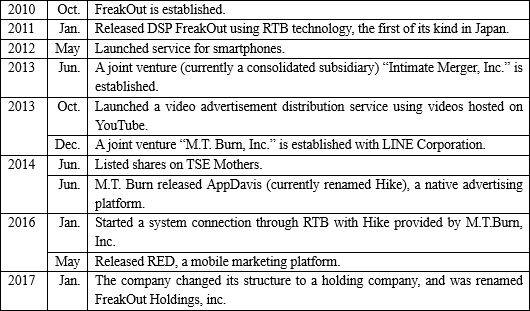  1-2 Philosophy 1-2 Philosophy FreakOut's philosophy is "Give People Work That Requires A Person."
As shown in the corporate history section, the company has its origin in the first commercialization of real-time transactions of Internet advertisements in Japan, with the aim of gradually changing the system of advertising transactions from manual operations to inter-computer transactions.
With the use of technologies, advertisers are now able to communicate with each and every consumer, approaching the true 1-to-1 marketing that was not possible with conventional mass-advertising.
At the same time, the "people" engaged in the advertising business are becoming freer from the transaction-related chores, and instead they are now able to dedicate more time to creative works such as planning more human-like communications and creating sympathetic messages.
The company believes its mission to be "generate surplus labor (the time for people to dedicate to their creativity) by letting computers do what they are good at."
The company is striving to contribute to a more creative society by "Giving People Work That Requires A Person" through the use of its advanced technologies in more diverse fields than just advertising.
FreakOut's philosophy is "Give People Work That Requires A Person."
As shown in the corporate history section, the company has its origin in the first commercialization of real-time transactions of Internet advertisements in Japan, with the aim of gradually changing the system of advertising transactions from manual operations to inter-computer transactions.
With the use of technologies, advertisers are now able to communicate with each and every consumer, approaching the true 1-to-1 marketing that was not possible with conventional mass-advertising.
At the same time, the "people" engaged in the advertising business are becoming freer from the transaction-related chores, and instead they are now able to dedicate more time to creative works such as planning more human-like communications and creating sympathetic messages.
The company believes its mission to be "generate surplus labor (the time for people to dedicate to their creativity) by letting computers do what they are good at."
The company is striving to contribute to a more creative society by "Giving People Work That Requires A Person" through the use of its advanced technologies in more diverse fields than just advertising.
 1-3 Overview of the Internet Advertising Market 1-3 Overview of the Internet Advertising Market To understand FreakOut's businesses, it is necessary to have some knowledge of environmental and constituent elements surrounding the operation of the "Internet advertisement," such as the changing needs of advertisers and media, and advertising markets, as well as the technologies and the main players. A few essential points are outlined below.
≪Changing advertising market≫
In the conventional advertising market, especially with the advertising businesses that exploited the mass media such as television and newspapers, monopolization and exclusivity of stock were of paramount importance in terms of business development for the supply side (i.e. the media and advertising agencies).
Major advertising agencies would have a near-total monopoly over the limited television ad spaces, enabling them to hold onto their pricing leadership against advertisers to continually generate huge profits in tandem with the media.
However, with the end of the era of strong economic growth and the advent of Internet advertising characterized by its interactivity and low-cost, compared to the conventional media, the demand for mass advertising via TV and newspapers is apt to decline.
As shown in the graph below, while Japan's total advertising spending has not grown in the last 10 years, Internet advertising expenses of 377.7 billion yen in 2005, which was less than 20% of Terrestrial TV and 40% of Newspapers, has grown 12.2% per year on average and reached 1,509.4 billion yen in 2017, which was 80% of Terrestrial TV and 30% of Newspapers. (Data from Dentsu "Japan's Advertising Market in 2017")
To understand FreakOut's businesses, it is necessary to have some knowledge of environmental and constituent elements surrounding the operation of the "Internet advertisement," such as the changing needs of advertisers and media, and advertising markets, as well as the technologies and the main players. A few essential points are outlined below.
≪Changing advertising market≫
In the conventional advertising market, especially with the advertising businesses that exploited the mass media such as television and newspapers, monopolization and exclusivity of stock were of paramount importance in terms of business development for the supply side (i.e. the media and advertising agencies).
Major advertising agencies would have a near-total monopoly over the limited television ad spaces, enabling them to hold onto their pricing leadership against advertisers to continually generate huge profits in tandem with the media.
However, with the end of the era of strong economic growth and the advent of Internet advertising characterized by its interactivity and low-cost, compared to the conventional media, the demand for mass advertising via TV and newspapers is apt to decline.
As shown in the graph below, while Japan's total advertising spending has not grown in the last 10 years, Internet advertising expenses of 377.7 billion yen in 2005, which was less than 20% of Terrestrial TV and 40% of Newspapers, has grown 12.2% per year on average and reached 1,509.4 billion yen in 2017, which was 80% of Terrestrial TV and 30% of Newspapers. (Data from Dentsu "Japan's Advertising Market in 2017")
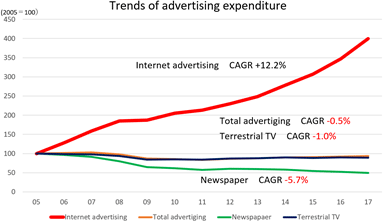 Meanwhile, the needs from advertisers for even more effective advertisements keep growing, creating a significant challenge in delivering "the right message" to "the right consumers" at "the right moment."
In this situation, there appeared a marketplace with open advertisement space called "Ad Exchange."
This is indeed a "marketplace" in which advertisers, the media and advertising agencies can freely trade advertisement space. For advertisers, this means that it has become even more important that they buy optimal advertisement space for an even better advertisement performance and one of the key technologies that enable this is "RTB," which was commercialized by the company for the first time in Japan.
≪Real-time transaction of advertisement space through RTB≫
RTB (Real-Time Bidding) is a distribution method that performs automatic transactions of advertisement space through bidding per impression (the number of times an advertisement is displayed).
Before RTB debuted, "a pure advertising transaction" was the norm. This was, as it were, a `set menu' in which the space for display advertisements (advertisements utilizing images, flash, videos, etc. displayed on websites) were sold to the media and advertising agencies as a package with impression guarantees and period guarantees attached.
In contrast, RTB analyzes the attributes of the user who accessed a display advertisement per impression, and performs a transaction by bidding as "an advertisement for a user with specific attributes" per impression.
The RTB technologies enable advertisers to engage with potential consumers whom it was previously difficult to reach through conventional pure advertising (buying advertisement space of specific websites at a pre-fixed price) or search advertising (relating to the keywords searched), and also make it possible to take recognition measures through a more effective advertisement distribution to elicit further interests and curiosity of users.
Meanwhile, the needs from advertisers for even more effective advertisements keep growing, creating a significant challenge in delivering "the right message" to "the right consumers" at "the right moment."
In this situation, there appeared a marketplace with open advertisement space called "Ad Exchange."
This is indeed a "marketplace" in which advertisers, the media and advertising agencies can freely trade advertisement space. For advertisers, this means that it has become even more important that they buy optimal advertisement space for an even better advertisement performance and one of the key technologies that enable this is "RTB," which was commercialized by the company for the first time in Japan.
≪Real-time transaction of advertisement space through RTB≫
RTB (Real-Time Bidding) is a distribution method that performs automatic transactions of advertisement space through bidding per impression (the number of times an advertisement is displayed).
Before RTB debuted, "a pure advertising transaction" was the norm. This was, as it were, a `set menu' in which the space for display advertisements (advertisements utilizing images, flash, videos, etc. displayed on websites) were sold to the media and advertising agencies as a package with impression guarantees and period guarantees attached.
In contrast, RTB analyzes the attributes of the user who accessed a display advertisement per impression, and performs a transaction by bidding as "an advertisement for a user with specific attributes" per impression.
The RTB technologies enable advertisers to engage with potential consumers whom it was previously difficult to reach through conventional pure advertising (buying advertisement space of specific websites at a pre-fixed price) or search advertising (relating to the keywords searched), and also make it possible to take recognition measures through a more effective advertisement distribution to elicit further interests and curiosity of users.
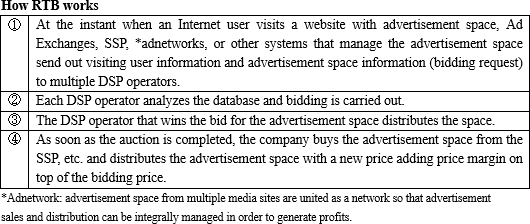 "RTB" requires two main players: "DSP (the demand-side system)" and "SSP (the supply-side system)" of advertisement space.
What is DSP (Demand Side Platform)?
DSP is a platform on which advertisers and advertising agencies can effectively purchase and distribute Internet advertisements so that they can maximize their profits.
More specifically, it is a platform where advertisers and advertising agencies perform an automatic bidding transaction and advertisement distribution per impression utilizing the RTB technologies and their own algorithms with Ad Exchanges, SSP, adnetworks and others.
Advertisers first determine the attributes of their target users and the maximum bidding price, and when a user who satisfies their criteria is found, bidding is instantaneously (within roughly 0.05 second) carried out and the advertisement with the highest bid is distributed on the medium.
Before RTB appeared, advertisers were forced to make an assumption as to which websites might be visited by the target users and then purchase specific advertisement slots at a pre-fixed price. However, DSP enables advertisers to make an assessment in real-time about the user to whom they want to distribute an advertisement. Furthermore, the advertisement can be distributed at a reasonable price through the bidding process, optimizing the cost effectiveness of the advertisement for the advertisers.
FreakOut's main businesses are the sales of its uniquely developed DSPs "Red" and "FreakOut" as well as the "DSP business" that supplies OEM.
To be able to regularly distribute advertisements to the right users and bid at the best price requires building highly advanced algorithms and training the AI (artificial intelligence) to be "even more intelligent" through repeated machine learning based on vast amounts of data. The company has a powerful competitive advantage on this matter (for more details, please refer to
"RTB" requires two main players: "DSP (the demand-side system)" and "SSP (the supply-side system)" of advertisement space.
What is DSP (Demand Side Platform)?
DSP is a platform on which advertisers and advertising agencies can effectively purchase and distribute Internet advertisements so that they can maximize their profits.
More specifically, it is a platform where advertisers and advertising agencies perform an automatic bidding transaction and advertisement distribution per impression utilizing the RTB technologies and their own algorithms with Ad Exchanges, SSP, adnetworks and others.
Advertisers first determine the attributes of their target users and the maximum bidding price, and when a user who satisfies their criteria is found, bidding is instantaneously (within roughly 0.05 second) carried out and the advertisement with the highest bid is distributed on the medium.
Before RTB appeared, advertisers were forced to make an assumption as to which websites might be visited by the target users and then purchase specific advertisement slots at a pre-fixed price. However, DSP enables advertisers to make an assessment in real-time about the user to whom they want to distribute an advertisement. Furthermore, the advertisement can be distributed at a reasonable price through the bidding process, optimizing the cost effectiveness of the advertisement for the advertisers.
FreakOut's main businesses are the sales of its uniquely developed DSPs "Red" and "FreakOut" as well as the "DSP business" that supplies OEM.
To be able to regularly distribute advertisements to the right users and bid at the best price requires building highly advanced algorithms and training the AI (artificial intelligence) to be "even more intelligent" through repeated machine learning based on vast amounts of data. The company has a powerful competitive advantage on this matter (for more details, please refer to  1-6 Characteristics & Strengths 1-6 Characteristics & Strengths ).
What is SSP (Supply Side Platform)?
SSP is a system that supports the maximization of advertisement effectiveness from the viewpoint of the media. It is a platform used by the media to manage and sell advertisement space and has the technologies to respond to real-time biddings from DSP.
This type of cost-effective advertising, based on the RTB technologies, which cleared the hurdles of optimization that were difficult to realize with conventional pure advertising is termed "performance-based advertising" and it is growing at a speed that is faster than that of Internet advertising as a whole.
In 2017, slightly more than 60% of Internet advertising in Japan was performance-based advertising. ).
What is SSP (Supply Side Platform)?
SSP is a system that supports the maximization of advertisement effectiveness from the viewpoint of the media. It is a platform used by the media to manage and sell advertisement space and has the technologies to respond to real-time biddings from DSP.
This type of cost-effective advertising, based on the RTB technologies, which cleared the hurdles of optimization that were difficult to realize with conventional pure advertising is termed "performance-based advertising" and it is growing at a speed that is faster than that of Internet advertising as a whole.
In 2017, slightly more than 60% of Internet advertising in Japan was performance-based advertising.
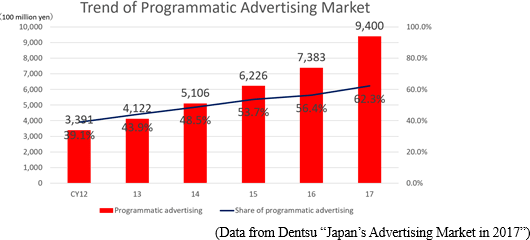 *Performance-based advertising: an advertising method which utilizes platforms that employ ad technologies processing vast amounts of data to provide automatic or instantaneous optimization of advertising. In addition to search engine advertising and some ad networks, major types include recently developed demand-side platforms (DSPs), ad exchanges, and supply-side platforms (SSPs). Performance-based advertising does not include ad space sales, tie-up ads, or affiliate advertising
The company's RTB commercialized in Japan is currently only less than 10% in size of its US counterpart, but it is growing rapidly. *Performance-based advertising: an advertising method which utilizes platforms that employ ad technologies processing vast amounts of data to provide automatic or instantaneous optimization of advertising. In addition to search engine advertising and some ad networks, major types include recently developed demand-side platforms (DSPs), ad exchanges, and supply-side platforms (SSPs). Performance-based advertising does not include ad space sales, tie-up ads, or affiliate advertising
The company's RTB commercialized in Japan is currently only less than 10% in size of its US counterpart, but it is growing rapidly.
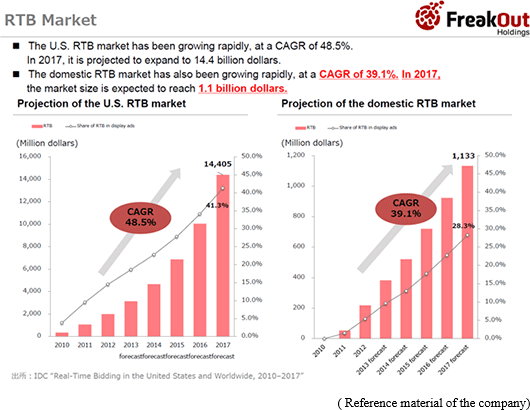 As seen here, "performance-based advertising" based on the remarkably fast-growing RTB technologies even within the Internet advertising, the sector showing the highest growth compared to the other media, is the company's main field. It is assuredly capitalizing on the robust demands and expanding its business operations.
In addition, while the company is actively working on expanding the overseas business mainly in Southeast Asia, as described later, the proportion of digital advertising expenses in the advertising market in each Southeast Asian country including Taiwan is also rising and the market is expanding continuously.
As seen here, "performance-based advertising" based on the remarkably fast-growing RTB technologies even within the Internet advertising, the sector showing the highest growth compared to the other media, is the company's main field. It is assuredly capitalizing on the robust demands and expanding its business operations.
In addition, while the company is actively working on expanding the overseas business mainly in Southeast Asia, as described later, the proportion of digital advertising expenses in the advertising market in each Southeast Asian country including Taiwan is also rising and the market is expanding continuously.
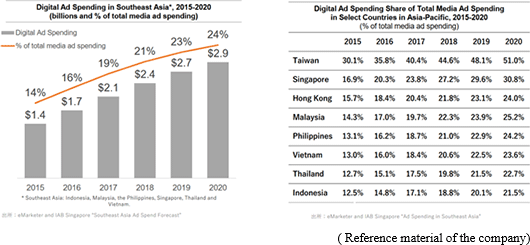  1-4 Business contents 1-4 Business contents 1. Business segments
There are three business segments: "DSP business," "DMP business," and "Other business."
1. Business segments
There are three business segments: "DSP business," "DMP business," and "Other business."
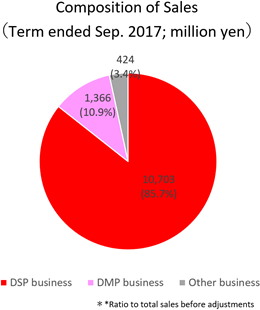 ① DSP business
◎ Business model
The Group purchases ad spaces through SSPs, ad exchanges, and media, and provides internet ad spaces to advertisers and ad agencies and provides the OEM service on DSP to some ad agencies. ① DSP business
◎ Business model
The Group purchases ad spaces through SSPs, ad exchanges, and media, and provides internet ad spaces to advertisers and ad agencies and provides the OEM service on DSP to some ad agencies.
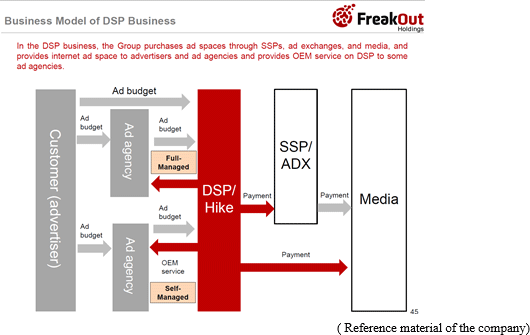 ◎ Service model
The company offers the following two types of services. ◎ Service model
The company offers the following two types of services.
 After the launch of these services, the company first concentrated on the direct sale to advertisers for the purposes of collecting a large amount of important data and directly receiving the voices of users, but now it mainly engages in the sale including OEM to ad agencies with the aim of boosting its sales growth.
For the ad agencies operating the company's service under their own brands, it is difficult to develop a DSP by themselves and newly enter this field from the viewpoints of server cost and difficulty in development, however, by utilizing the basic function of DSP and infrastructure of FreakOut Holdings, it makes it possible to enter the field early.
◎ Major products and services
The company aims to maximize the effect of ad distribution via DSP "Red" and "FreakOut," by utilizing the private DMP "MOTHER," an original analysis software which analyzes big data such as access data to each advertiser's website, ad distribution data, membership data, and purchase data.
"Red" and "FreakOut" have various methods for ad distribution, in order for advertisers to target prospective customers. In detail, they distribute ads that choose targets based on the behaviors of consumers using the following methods: (1) methods such as "Audience Expansion" for reaching "those who do not know the advertiser's products/services (prospective customers)," (2) methods such as "Keyword Match" for reaching "those who know advertisers' products/services (people who have interests)," and (3) methods such as "Retargeting" for promoting "those who want advertisers' products/services (expected customers)" to take action by purchasing products, requesting a brochure, getting registered as a member, etc.
After the launch of these services, the company first concentrated on the direct sale to advertisers for the purposes of collecting a large amount of important data and directly receiving the voices of users, but now it mainly engages in the sale including OEM to ad agencies with the aim of boosting its sales growth.
For the ad agencies operating the company's service under their own brands, it is difficult to develop a DSP by themselves and newly enter this field from the viewpoints of server cost and difficulty in development, however, by utilizing the basic function of DSP and infrastructure of FreakOut Holdings, it makes it possible to enter the field early.
◎ Major products and services
The company aims to maximize the effect of ad distribution via DSP "Red" and "FreakOut," by utilizing the private DMP "MOTHER," an original analysis software which analyzes big data such as access data to each advertiser's website, ad distribution data, membership data, and purchase data.
"Red" and "FreakOut" have various methods for ad distribution, in order for advertisers to target prospective customers. In detail, they distribute ads that choose targets based on the behaviors of consumers using the following methods: (1) methods such as "Audience Expansion" for reaching "those who do not know the advertiser's products/services (prospective customers)," (2) methods such as "Keyword Match" for reaching "those who know advertisers' products/services (people who have interests)," and (3) methods such as "Retargeting" for promoting "those who want advertisers' products/services (expected customers)" to take action by purchasing products, requesting a brochure, getting registered as a member, etc.
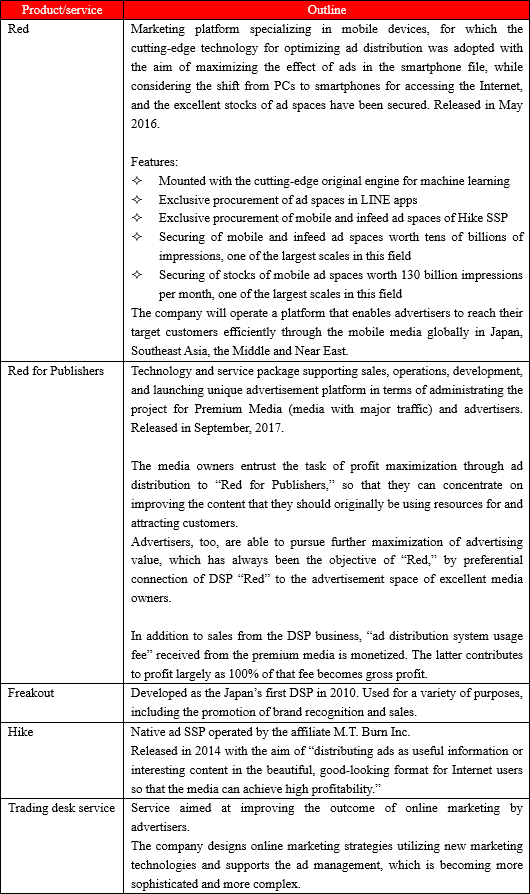 ② DMP business
DMP stands for Data Management Platform, which is a data integration management tool for managing and analyzing the data of access to advertisers' websites, ad distribution, membership, etc. and enabling the use of the data in cooperation with data utilization channels, for email distribution, analysis, surveys, etc.
In order to actualize the optimization of data marketing conducted by client companies and ad agencies, the company collects vast amounts of data from data providers, including media companies and research firms, and stores and analyzes data on DMP to provide the unique DMP for an enormous amount of public data, support the development of the DMP for large-scale portal sites, and offer consulting services utilizing the company's own data with optimal marketing channels, etc. ② DMP business
DMP stands for Data Management Platform, which is a data integration management tool for managing and analyzing the data of access to advertisers' websites, ad distribution, membership, etc. and enabling the use of the data in cooperation with data utilization channels, for email distribution, analysis, surveys, etc.
In order to actualize the optimization of data marketing conducted by client companies and ad agencies, the company collects vast amounts of data from data providers, including media companies and research firms, and stores and analyzes data on DMP to provide the unique DMP for an enormous amount of public data, support the development of the DMP for large-scale portal sites, and offer consulting services utilizing the company's own data with optimal marketing channels, etc.
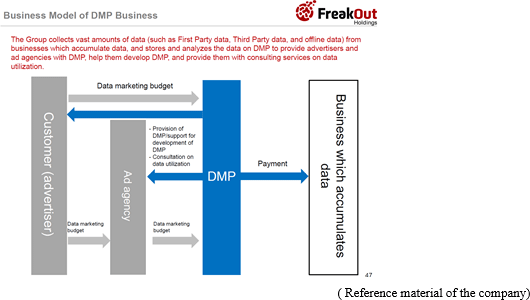 ③ Other business
This is a new business segment established in the term ended Sep. 2017, as the company shifted to the holdings company system. New businesses and business administration in the group companies inside and outside Japan are included in this segment. ③ Other business
This is a new business segment established in the term ended Sep. 2017, as the company shifted to the holdings company system. New businesses and business administration in the group companies inside and outside Japan are included in this segment.
 1-5 Group companies 1-5 Group companies Under the management of the holdings company FreakOut Holdings, inc., the followings are the companies that constitute the corporate group.
Under the management of the holdings company FreakOut Holdings, inc., the followings are the companies that constitute the corporate group.
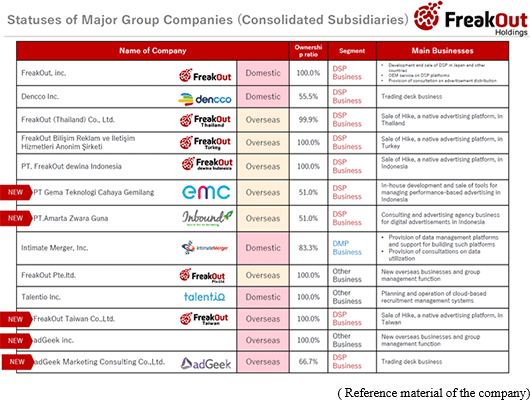 In addition, the company owns M.T. Burn Co., Ltd., (domestic, ownership ratio of 49.5%), which develops and sells advertising platforms for smartphones as an affiliated company accounted for by the equity method.
As for the overseas business, they have been mainly operating the native ad platform business with FreakOut Pte. Ltd. (headquartered in Singapore) serving as the headquarters.
Since a native ad platform was released for the first time in Southeast Asia in 2015, the company has formed tie-ups with mainly the leading media in each country, and currently over 700 advertisers use the service of FreakOut.
In July 2017, the company entered the Hong Kong market and established local subsidiaries in Vietnam, Malaysia, the Philippines, India, and Iran as new bases in Southeast Asia, following the existing ones in Singapore, Thailand, and Indonesia. Also, the company actively promotes M&A and forms alliances with the premium media in each country. It also offers the native ad platform in Asia and the Middle East.
In addition, the company owns M.T. Burn Co., Ltd., (domestic, ownership ratio of 49.5%), which develops and sells advertising platforms for smartphones as an affiliated company accounted for by the equity method.
As for the overseas business, they have been mainly operating the native ad platform business with FreakOut Pte. Ltd. (headquartered in Singapore) serving as the headquarters.
Since a native ad platform was released for the first time in Southeast Asia in 2015, the company has formed tie-ups with mainly the leading media in each country, and currently over 700 advertisers use the service of FreakOut.
In July 2017, the company entered the Hong Kong market and established local subsidiaries in Vietnam, Malaysia, the Philippines, India, and Iran as new bases in Southeast Asia, following the existing ones in Singapore, Thailand, and Indonesia. Also, the company actively promotes M&A and forms alliances with the premium media in each country. It also offers the native ad platform in Asia and the Middle East.
 1-6 Characteristics and strengths 1-6 Characteristics and strengths As mentioned above, in order to distribute ads to the right users and submit a bid at the best price, it is necessary to develop an extremely advanced algorithm and repeat machine learning based on a large amount of data to actualize "smart artificial intelligence (AI)." At this point, the company possesses a significant competitive advantage. Having good ad spaces is its advantage as well.
① The largest amount of data
Since the company commercialized the RTB technology for the first time in Japan, it possesses the largest amount of data in Japan.
No matter how superior AI is, it will not grow to a practical and effective AI, unless machine learning is repeated with vast amounts of data.
The company, which "knows about smartphone owners the most in Japan", with accurate data of 3 million users (5%) out of 60 million mobile users in Japan, it is possible to predict the thoughts and behaviors of the remaining 57 million users according to age and gender. Therefore, the satisfaction level of advertisers towards this strength of the company is high.
② Securing of good-quality ad spaces
After RTB debuted, the "smartness" of a platform in an open environment has become important, whereas the gap in technology levels shrank over a certain period of time. As a result, the quality and exclusiveness of ad spaces, in particular, became the major competitive conditions in the mobile field again.
In these circumstances, LINE Corporation and FreakOut Holdings hold 50.4% and 49.5%, respectively, of M. T. Burn Inc., the company's equity-method affiliate. Accordingly, FreakOut Holdings exclusively secures the ad spaces of LINE apps and presents high performance to advertisers.
③ Active investment for developing a superior algorithm
For targeting advertisement, it is possible to win a bid by submitting the highest bid. As the company aims to expand sales, it wants to purchase as many ad spaces as possible, but if ad performance is poor, advertisers will not evaluate it highly, which will make it difficult to continue transactions with them.
This indicates that it is essential to produce reasonable results for clients even when the ad cost was high.
Therefore, the company has developed "a model for predicting rate of clicking" and "a model for predicting rate of conversion," boosting the capability of giving proposals to advertisers, and constantly carries out investment for further improving the accuracy of these models.
The data science team of the company has top-level abilities among Japanese mid-sized companies, so their accumulated active investment is leading to continuous high performance.
④ Securing of talented personnel
In a survey called "popularity ranking of companies among the students of Tokyo and Kyoto Universities" conducted by a magazine, the company has been ranked high along with some renowned large IT companies, foreign financial institutions and other global manufacturers at 28th, which is 79 ranks higher than the previous year's 107th rank.
In addition to active utilization of the internship system to increase the contact points with students, possibilities to work in wider and new fields such as HR tech and Fintech despite having the adverting as the core business and being able to work with some renowned and excellent engineers of the industry as an engineer, are reasons why they are attracted to the company.
Also, the company considers the incentive system that evaluates the challenges to the maximum is one of the factors for its popularity.
As mentioned above, in order to distribute ads to the right users and submit a bid at the best price, it is necessary to develop an extremely advanced algorithm and repeat machine learning based on a large amount of data to actualize "smart artificial intelligence (AI)." At this point, the company possesses a significant competitive advantage. Having good ad spaces is its advantage as well.
① The largest amount of data
Since the company commercialized the RTB technology for the first time in Japan, it possesses the largest amount of data in Japan.
No matter how superior AI is, it will not grow to a practical and effective AI, unless machine learning is repeated with vast amounts of data.
The company, which "knows about smartphone owners the most in Japan", with accurate data of 3 million users (5%) out of 60 million mobile users in Japan, it is possible to predict the thoughts and behaviors of the remaining 57 million users according to age and gender. Therefore, the satisfaction level of advertisers towards this strength of the company is high.
② Securing of good-quality ad spaces
After RTB debuted, the "smartness" of a platform in an open environment has become important, whereas the gap in technology levels shrank over a certain period of time. As a result, the quality and exclusiveness of ad spaces, in particular, became the major competitive conditions in the mobile field again.
In these circumstances, LINE Corporation and FreakOut Holdings hold 50.4% and 49.5%, respectively, of M. T. Burn Inc., the company's equity-method affiliate. Accordingly, FreakOut Holdings exclusively secures the ad spaces of LINE apps and presents high performance to advertisers.
③ Active investment for developing a superior algorithm
For targeting advertisement, it is possible to win a bid by submitting the highest bid. As the company aims to expand sales, it wants to purchase as many ad spaces as possible, but if ad performance is poor, advertisers will not evaluate it highly, which will make it difficult to continue transactions with them.
This indicates that it is essential to produce reasonable results for clients even when the ad cost was high.
Therefore, the company has developed "a model for predicting rate of clicking" and "a model for predicting rate of conversion," boosting the capability of giving proposals to advertisers, and constantly carries out investment for further improving the accuracy of these models.
The data science team of the company has top-level abilities among Japanese mid-sized companies, so their accumulated active investment is leading to continuous high performance.
④ Securing of talented personnel
In a survey called "popularity ranking of companies among the students of Tokyo and Kyoto Universities" conducted by a magazine, the company has been ranked high along with some renowned large IT companies, foreign financial institutions and other global manufacturers at 28th, which is 79 ranks higher than the previous year's 107th rank.
In addition to active utilization of the internship system to increase the contact points with students, possibilities to work in wider and new fields such as HR tech and Fintech despite having the adverting as the core business and being able to work with some renowned and excellent engineers of the industry as an engineer, are reasons why they are attracted to the company.
Also, the company considers the incentive system that evaluates the challenges to the maximum is one of the factors for its popularity.
 1-7 ROE Analysis 1-7 ROE Analysis
 For the term ended Sep. 2017, all three elements contributed to increase ROE considerably.
For the term ended Sep. 2017, all three elements contributed to increase ROE considerably.
|
| 1HF of Fiscal Year September 2018 Earnings Results |
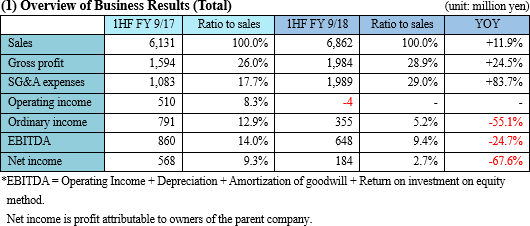 Sales Increased but Profit Dropped due to Upfront Investment
Sales were 6,862 million yen, up 11.9% year on year. Both businesses were healthy. Sales marked a record high for the first half with newly merged and acquired companies of overseas ad business contributing.
Operating income saw a loss of 4 million yen. EBITDA decreased 24.7% year on year to 648 million yen. The company is actively recruiting mainly engineers to expand new business, and the number of employees has increased significantly. The decrease in ordinary income shrank in comparison to operating income as return on investment on equity method in non-operating income increased 142 million yen year on year. Sales Increased but Profit Dropped due to Upfront Investment
Sales were 6,862 million yen, up 11.9% year on year. Both businesses were healthy. Sales marked a record high for the first half with newly merged and acquired companies of overseas ad business contributing.
Operating income saw a loss of 4 million yen. EBITDA decreased 24.7% year on year to 648 million yen. The company is actively recruiting mainly engineers to expand new business, and the number of employees has increased significantly. The decrease in ordinary income shrank in comparison to operating income as return on investment on equity method in non-operating income increased 142 million yen year on year.
 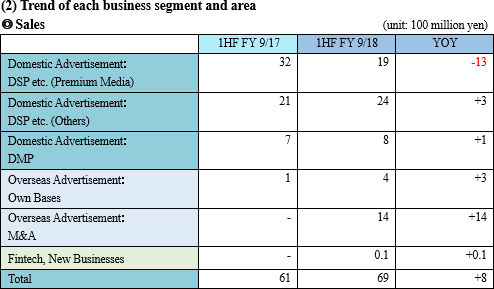  Sales dropped in the domestic market. While the sales of certain major media related products were sluggish, the new product "Red for Publishers" is growing steadily. The domestic advertising business strategy strongly promotes Red for Publishers, a service for multiple premium media, so as not to rely on one company.
Overseas sales increased sharply. In addition to the growth of the established subsidiaries, Taiwan's adGeek Marketing Consulting, which was merged and acquired in Sep. 2017, started contributing from the current term.
Sales dropped in the domestic market. While the sales of certain major media related products were sluggish, the new product "Red for Publishers" is growing steadily. The domestic advertising business strategy strongly promotes Red for Publishers, a service for multiple premium media, so as not to rely on one company.
Overseas sales increased sharply. In addition to the growth of the established subsidiaries, Taiwan's adGeek Marketing Consulting, which was merged and acquired in Sep. 2017, started contributing from the current term.
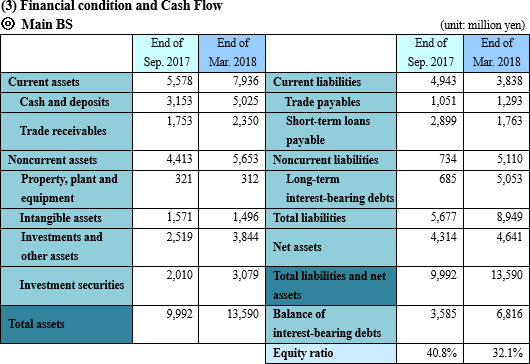 Current assets grew 2,358 million yen from the end of the previous term due to the increase in cash and deposits and trade receivables. As investment securities rose, noncurrent assets increased 1,239 million yen from the end of the previous term and total assets rose by 3,598 million yen from the end of the previous term to 13,590 million yen.
Total liabilities augmented 3,271 million yen from the end of the previous term to 8,949 million yen, due to the issuance of convertible bond-type bonds with subscription rights to shares.
Net assets grew 326 million yen from the end of the previous term to 4,641 million yen, due to the rise in capital, capital surplus and retained earnings.
As a result, capital-to-asset ratio dropped 8.7% from 40.8% at the end of the previous term to 32.1%.
Current assets grew 2,358 million yen from the end of the previous term due to the increase in cash and deposits and trade receivables. As investment securities rose, noncurrent assets increased 1,239 million yen from the end of the previous term and total assets rose by 3,598 million yen from the end of the previous term to 13,590 million yen.
Total liabilities augmented 3,271 million yen from the end of the previous term to 8,949 million yen, due to the issuance of convertible bond-type bonds with subscription rights to shares.
Net assets grew 326 million yen from the end of the previous term to 4,641 million yen, due to the rise in capital, capital surplus and retained earnings.
As a result, capital-to-asset ratio dropped 8.7% from 40.8% at the end of the previous term to 32.1%.
 While more shares of the affiliated companies and investment securities were acquired in comparison to the previous term, the cash position rose significantly as the company raised funds through the issuance of convertible bond-type bonds with subscription rights to shares and shares.
While more shares of the affiliated companies and investment securities were acquired in comparison to the previous term, the cash position rose significantly as the company raised funds through the issuance of convertible bond-type bonds with subscription rights to shares and shares.
|
| Fiscal Year September 2018 Earnings Estimates |
 No change in earnings forecasts. Sales are estimated to grow considerably, but profit is forecasted to decline due to upfront investment.
No change has been made to the earnings forecasts. The company recognizes the term ending Sep. 2018 as the year for implementing active investment for achieving the goals in 2019 and 2020 while improving its existing business steadily.
Sales are forecasted to grow 34.0% year on year to 16.1 billion yen. Overseas ad business is expected to contribute largely.
Operating income is projected to drop by 95.0% year on year to 720 million yen. Since the company will carry out upfront investment in a new business, a temporary decline in profit is estimated. No change in earnings forecasts. Sales are estimated to grow considerably, but profit is forecasted to decline due to upfront investment.
No change has been made to the earnings forecasts. The company recognizes the term ending Sep. 2018 as the year for implementing active investment for achieving the goals in 2019 and 2020 while improving its existing business steadily.
Sales are forecasted to grow 34.0% year on year to 16.1 billion yen. Overseas ad business is expected to contribute largely.
Operating income is projected to drop by 95.0% year on year to 720 million yen. Since the company will carry out upfront investment in a new business, a temporary decline in profit is estimated.
 The company considers that both sales and profit are progressing according to the plan
(2)Medium-term plan
FreakOut HD aims to achieve "sales of 33 billion yen and an EBITDA of 3 billion yen" in the term ending Sep. 2020. In the coming three years, the company will strive to increase sales and EBITDA by 2.8 times and 2.1 times, respectively, from the results for the term ended Sep. 2017.
It is expected that the sales of domestic ads will grow steadily while the overseas ad business will serve as a growth driver.
The company considers that both sales and profit are progressing according to the plan
(2)Medium-term plan
FreakOut HD aims to achieve "sales of 33 billion yen and an EBITDA of 3 billion yen" in the term ending Sep. 2020. In the coming three years, the company will strive to increase sales and EBITDA by 2.8 times and 2.1 times, respectively, from the results for the term ended Sep. 2017.
It is expected that the sales of domestic ads will grow steadily while the overseas ad business will serve as a growth driver.
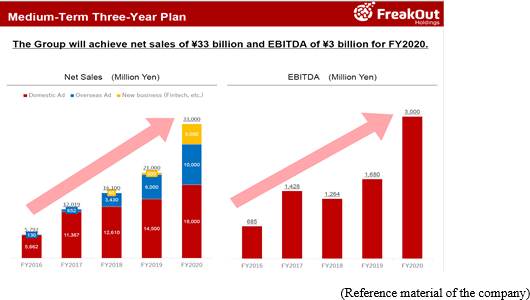 |
| Progress of Each Business |
|
◎ Digital Signage Business
Approximately 4,000 tablets were installed as of the end of March 2018. The company plans to introduce 15,000 tablets this year and aims to install 50,000 tablets by 2020.
The company is conducting its business activities for expansion of Nihon Kotsu in local core cities excluding Tokyo, and it is also preparing for the trial with major leading partners in Southeast Asia for overseas expansion.
In addition, the company enabled the connection to the ad distribution system provided by Google Inc. in March 2018, and distribution of the Nikkei electronic version was started in April 2018.
Currently the company is not accounted for by the equity method, but it is anticipated to contribute to profit through the equity method (49% ownership) in future.
◎ Overseas Business◎
*M&A of two companies in Thailand
The company acquired two companies, Digitiv and Dot gf, which engage in comprehensive digital marketing business in Thailand.
This enabled the company to offer various solutions related to digital marketing in all the areas of Southeast Asia and Taiwan, together with adGeek in Taiwan and EMC and InboundID in Indonesia.
It will continue the active M&A strategy.
*Signed an exclusive distribution agreement in Southeast Asia for SilverPush's products
FreakOut Holdings, Inc. signed an exclusive distribution agreement in Southeast Asia for the products of India's SilverPush, where the company made investments.
"TVCM interlocking distribution platform" provided by SilverPush is a platform that incorporates a machine learning engine developed by the company in video and voice analysis using fingerprint technology, which enables a high-performance and real-time TVCM interlocking distribution. It detects the TVCM of competitors and the company in real time, and places digital ads in a few seconds or few minutes.
The company plans to develop a TVCM-linked platform with technology as its strength in a market with strong demand for brand advertising in Southeast Asia, contributing to overseas expansion of the investment destinations.
◎ Domestic Advertising Business
The company is expanding its products for the media.
*Construction of a unique advertising platform and sales support by Red for Publishers
Nowadays, the reliability of the media which is the distribution destination is being doubted, because of the problem of an ad fraud that inflicts invalid impressions and clicks by using an application software called bot, which executes automated tasks on the Internet, and illegally inflates advertisement effects and the number of contracts for advertisement expenses. Therefore, advertisers are getting stricter about general programmatic ads.
Under such circumstances, the company's Red for Publishers supports the construction of a unique advertising platform for the premium media isolated from ad frauds, and its advanced technology and achievements are appreciated.
While the lead time until the market launch has been long in order to build a deep collaborative relationship with the premium media, market needs are high and the company is establishing a position superior to its competitors.
*Native SSP "Poets"
"Poets" released in the second quarter of the current term is narrowing down the media that provides high quality content and promoting partnership. It is a product that meets the needs of the media owners aiming for monetization in a manner that it does not hinder the user experience with lower cost, in addition to the development and expansion of unique advertising products.
Since the company is using the knowledge and know-how gained through its affiliated company M.T. Burn, sales have been growing rapidly although it has been just released and further expansion from the second-half is anticipated.
|
| Conclusions |
|
While the problem of ad frauds is becoming apparent in the Internet advertising industry, causing advertisers to get stricter to foamy media and agencies dealing with them, the reliability of the premium media is becoming relatively higher, and this structure is thought to become more obvious in future.
Under such circumstances, the company that targets the premium media is in an advantageous position to firmly capture the needs of the advertisers. We would like to pay attention to when the investments made in this term will start showing the results along with the progress of new businesses such as IRIS and Fintech making use of this advantage.
|
| <Reference: Regarding corporate governance> |
 ◎ Corporate Governance Report
Last modified: February 15, 2018.
<Basic Policy>
The company believes that improving management efficiency, management soundness, transparency and compliance will enhance the corporate value from a long-term perspective, and by doing so, it can return profits to many stakeholders including shareholders. In order to enhance the management soundness, transparency and compliance, it is important to build an organizational structure that can respond swiftly and flexibly to changes in the business environment while improving the corporate governance. The company carries out efficient management based on the viewpoints of shareholder who are the owners of the company.
<Reasons for Non-compliance with the Principles of the Corporate Governance Code (Excerpts)>
It is mentioned that "our company follows all of the basic principles of the Corporate Governance Code." ◎ Corporate Governance Report
Last modified: February 15, 2018.
<Basic Policy>
The company believes that improving management efficiency, management soundness, transparency and compliance will enhance the corporate value from a long-term perspective, and by doing so, it can return profits to many stakeholders including shareholders. In order to enhance the management soundness, transparency and compliance, it is important to build an organizational structure that can respond swiftly and flexibly to changes in the business environment while improving the corporate governance. The company carries out efficient management based on the viewpoints of shareholder who are the owners of the company.
<Reasons for Non-compliance with the Principles of the Corporate Governance Code (Excerpts)>
It is mentioned that "our company follows all of the basic principles of the Corporate Governance Code."
Disclaimer
This report is intended solely for information purposes, and is not intended as a solicitation for investment. The information and opinions contained within this report are made by our company based on data made publicly available, and the information within this report comes from sources that we judge to be reliable. However, we cannot wholly guarantee the accuracy or completeness of the data. This report is not a guarantee of the accuracy, completeness or validity of said information and opinions, nor do we bear any responsibility for the same. All rights pertaining to this report belong to Investment Bridge Co., Ltd., which may change the contents thereof at any time without prior notice. All investment decisions are the responsibility of the individual and should be made only after proper consideration.Copyright (C) 2018 Investment Bridge Co., Ltd. All Rights Reserved. |

